My clock concept underwent some serious changes as it progressed. At first, my plan was to have a city which built itself and then destroyed itself every 24 hours, as shown in the schematics below:
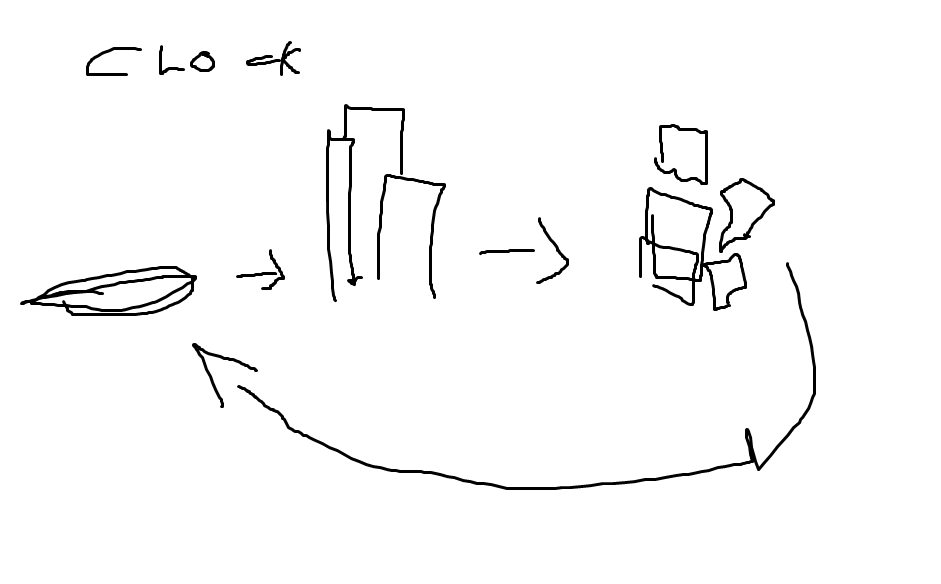
Using toxiclibs, I managed to create a class which would create a flat plane in 3D space. As time progressed, boxes would emerge from the plane and grow upwards to a predetermined stop height. The problem was that if the plane was slanted in any direction, the boxes would still go straight up. I spent roughly 12 hours trying to fix this, but without any specific plan or debugging methodology, I only managed to waste loads of time and create more errors with the box generation. I ditched the idea of boxes for lines, which were much less time consuming to deal with. In the end, I managed to create a class which would accept any mesh, and generate lines which grow out of the given mesh in a specific direction. Thus, when a mesh that looks like this:
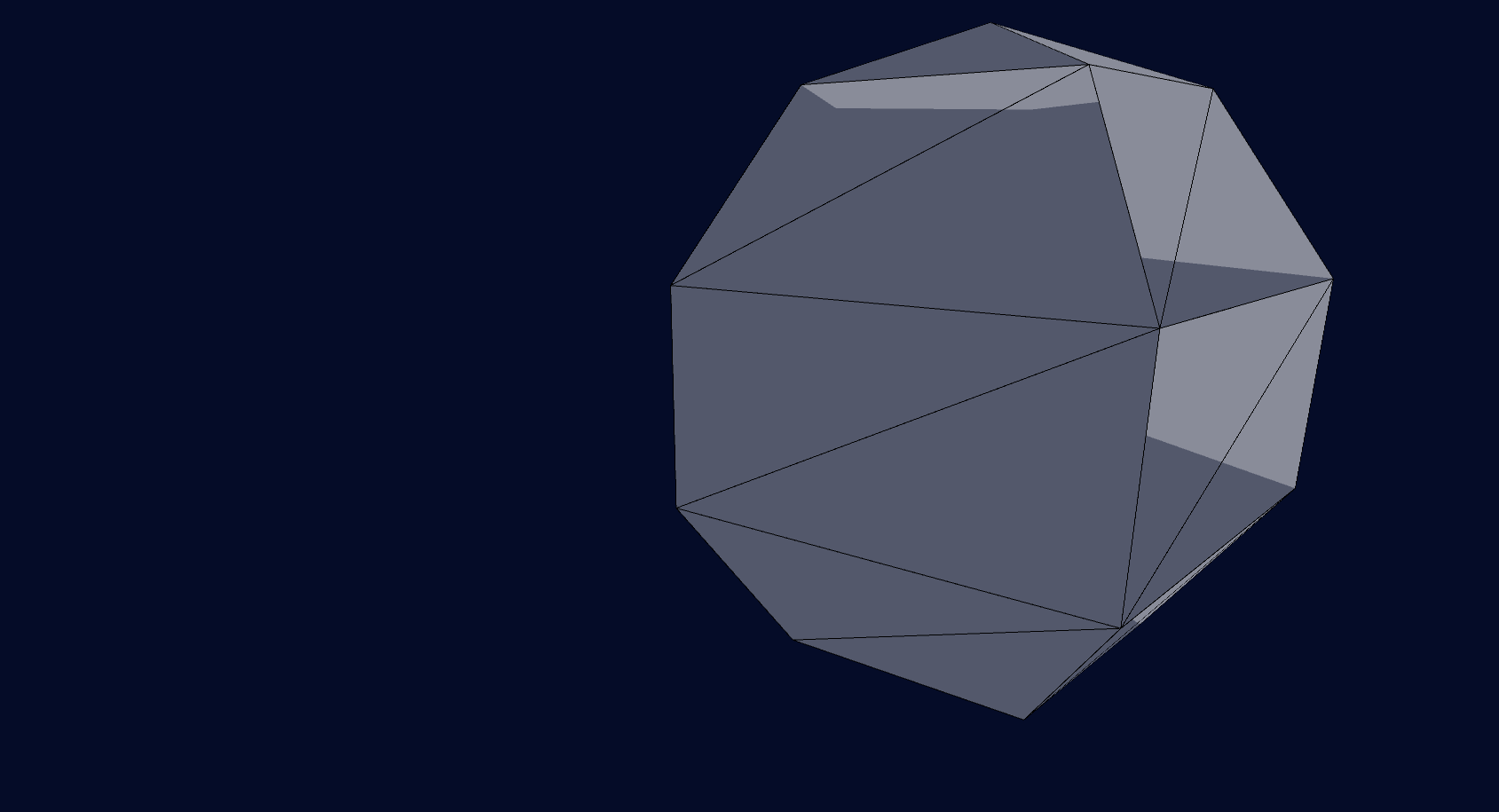
is fed into the class, this is the result:
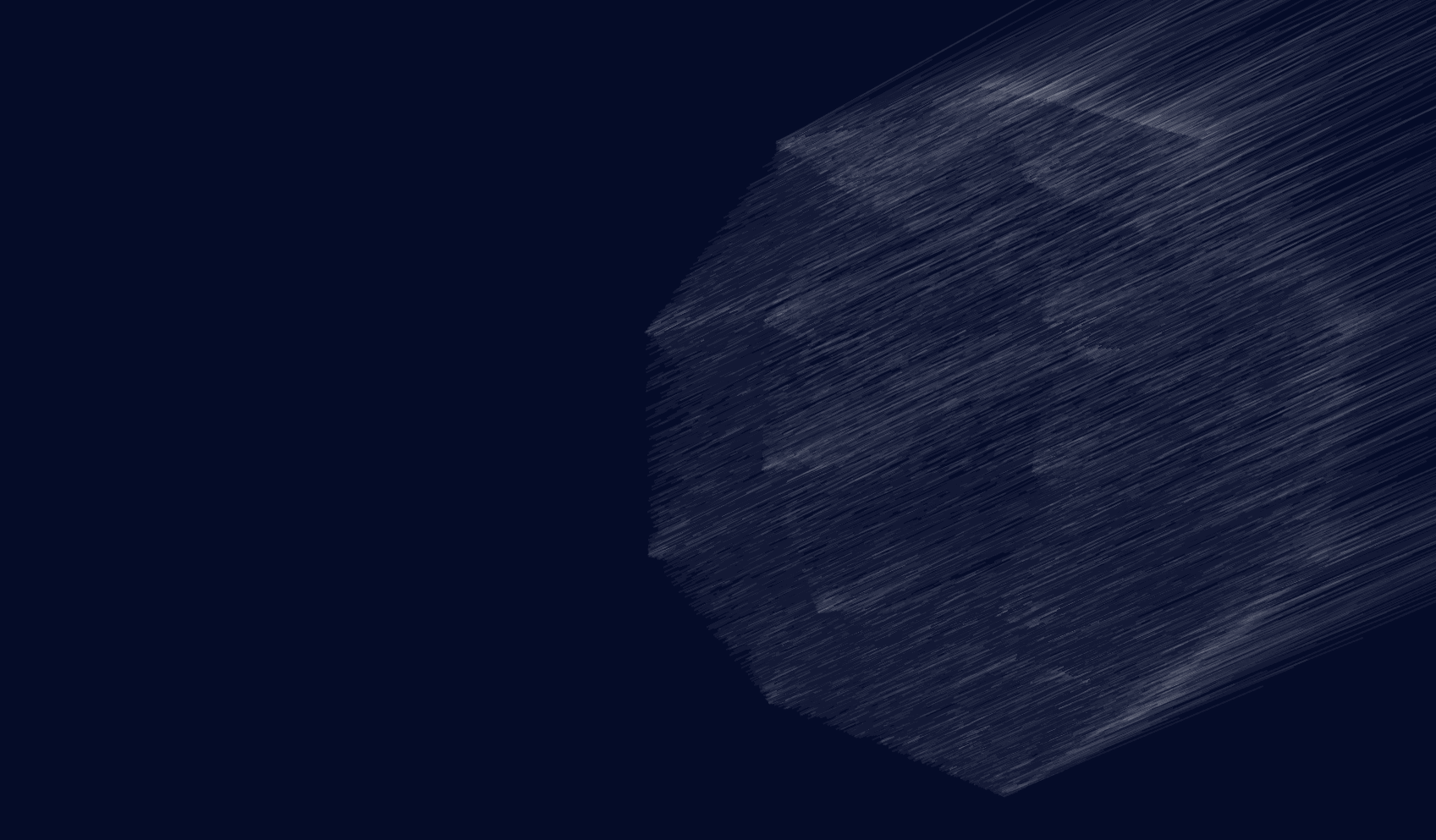
captured in motion:

I inserted a shape into a 3D environment:
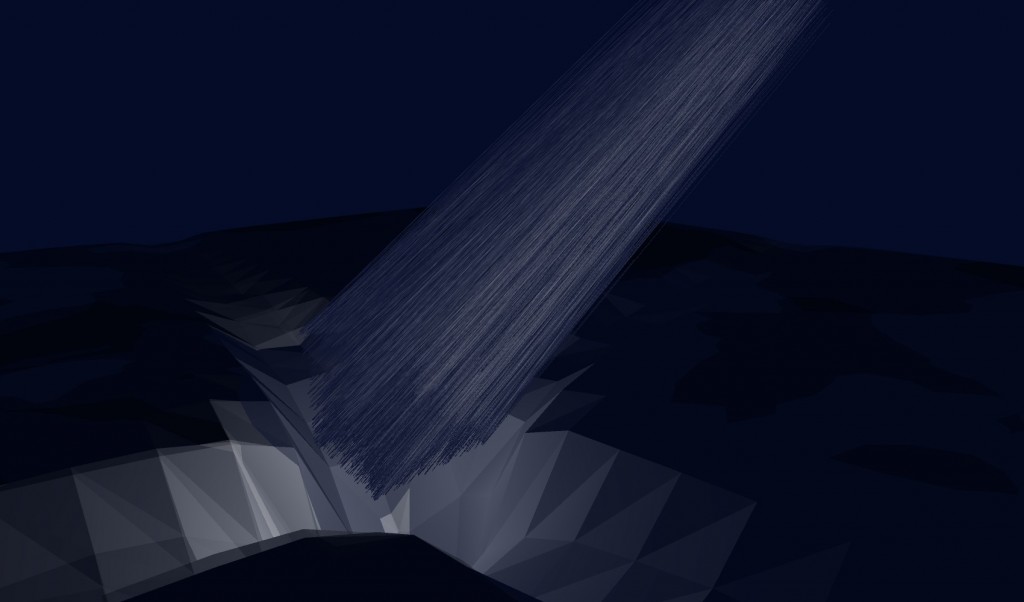
Originally, I planned to make the lines simply grow in different directions based on the time of day, but that didn’t seem to involve the surrounding terrain at all. Instead, I raised the shape high above the land, and altered the topography:
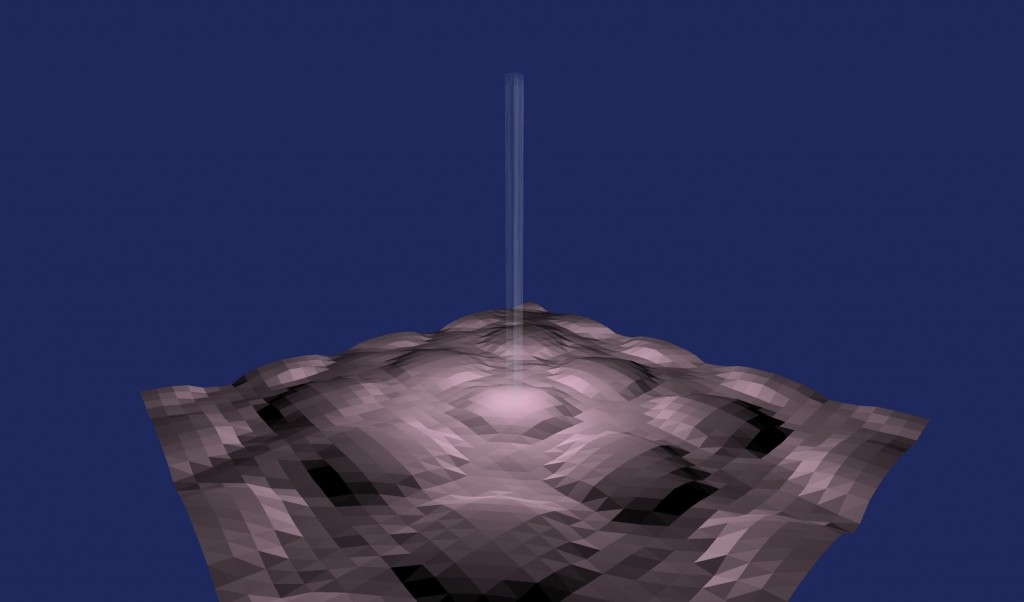
The beam of light moves to predetermined points (the intersections of the crevices between hills) around the terrain once per minute. A sped up section of random movement is shown here:
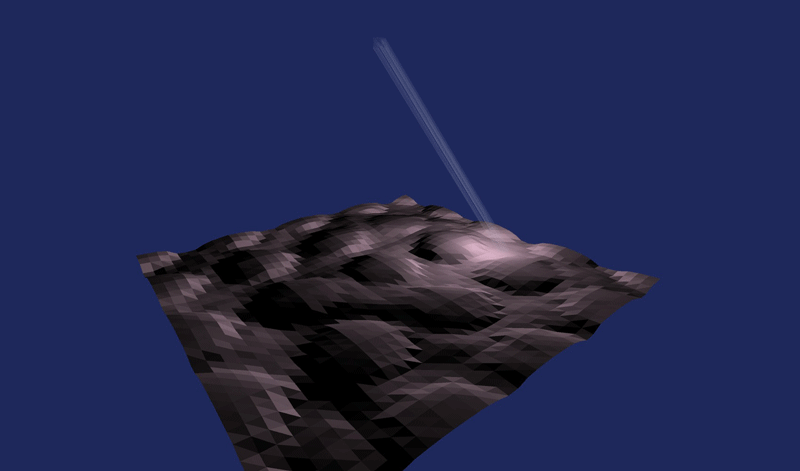
While at these points, the light will distort the surface of the terrain in one of five ways:
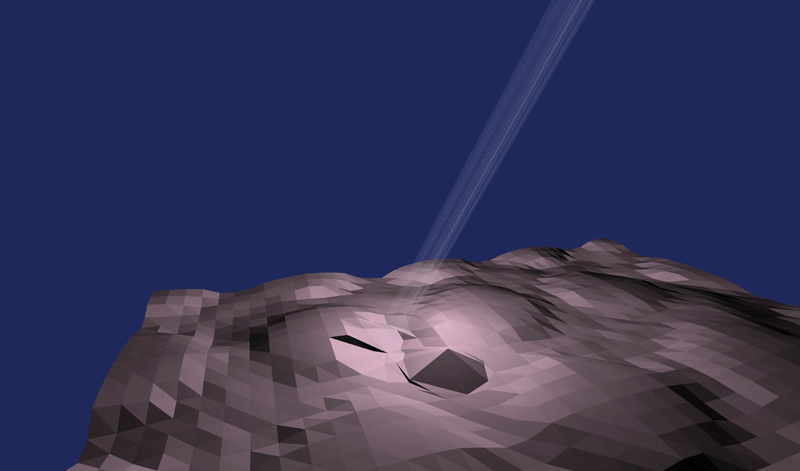
The light pulls the land up toward it

The light expands the land, making it grow outwards
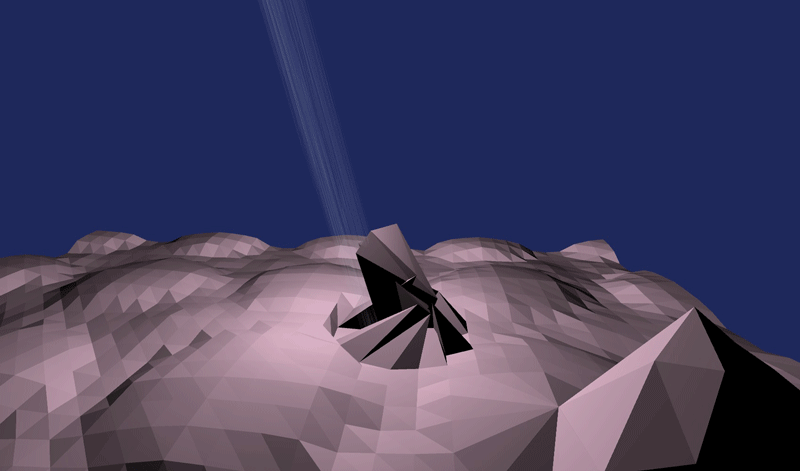
The light collapses the land down to a single point

The light stirs the land around
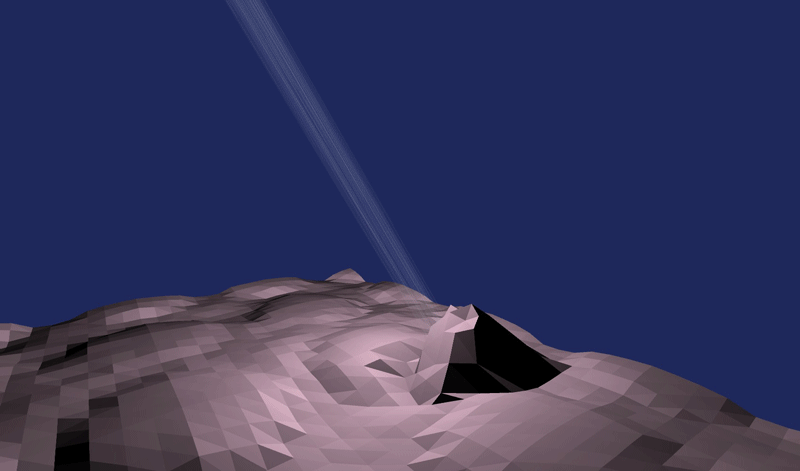
The light pushes the land away from it
Every hour, the mesh is reset. One can look at the mesh and, judging its degree of distortion, tell how far into the current hour one is. Implementing a way to tell which hour is the next step, but currently this is only a one hour clock.
Here is a timelapse of the clock in action:
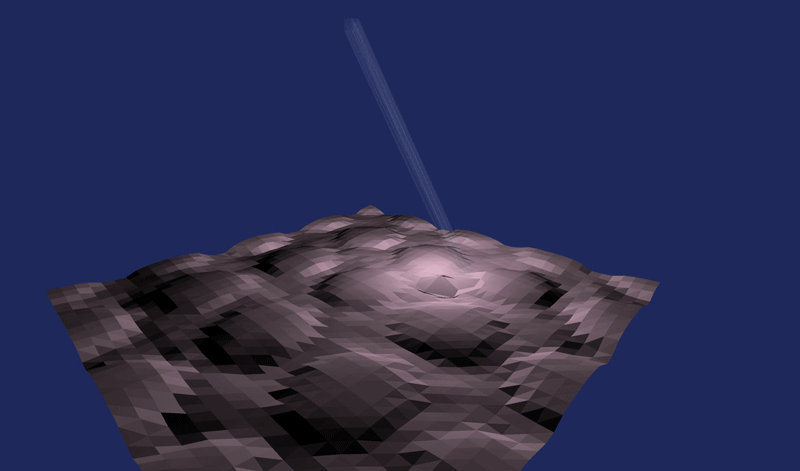
Code:
import toxi.color.*;
import toxi.color.theory.*;
import toxi.physics2d.constraints.*;
import toxi.physics.*;
import toxi.physics.constraints.*;
import toxi.physics.behaviors.*;
import toxi.math.conversion.*;
import toxi.geom.*;
import toxi.math.*;
import toxi.util.datatypes.*;
import toxi.util.events.*;
import toxi.geom.mesh.subdiv.*;
import toxi.geom.mesh.*;
import toxi.math.waves.*;
import toxi.util.*;
import toxi.math.noise.*;
import java.util.*;
import toxi.processing.*;
import java.util.*;
import processing.opengl.*;
int timeChange;
Viewer v;
Mesh3D shape;
ToxiclibsSupport gfx;
SuperStructure struc;
VerletPhysics world;
Land land;
Agent3D zapPos;
int imginc, curMin, curHour;
void setup(){
size(1700,1000,OPENGL);
v = new Viewer(-1280,-776,-1109, new Vec3D());
struc = new SuperStructure(0,-1000,0,(TriangleMesh)new AABB(20).toMesh(),new Vec3D(0,1,0),100,83,2000,1);
gfx = new ToxiclibsSupport(this);
world = new VerletPhysics();
land = new Land(0,50,0,new Vec3D());
imginc = 0;
timeChange = 0;
zapPos = new Agent3D(0,0,0,new Vec3D());
zapPos.maxSpeed = 15.0;
zapPos.maxForce = 5.0;
curMin = minute();
curHour = hour();
zapPos.setSeekPt(land.marks.get(int(random(land.marks.size()))));
struc.zapPoint(zapPos);
}
void draw(){
noCursor();
background(30,40,90);
if(curMin != minute()){
zapPos.setSeekPt(land.marks.get(int(random(land.marks.size()))));
struc.zapPoint(zapPos);
curMin = minute();
land.changeRule(int(random(5)));
imginc++;
}
if(curHour != hour()){
land.reconfiguring = true;
curHour = hour();
}
world.update();
zapPos.run(gfx);
Vec3D lightPos = struc.interpolateTo(zapPos,0.8);
pointLight(220,180,200,lightPos.x,lightPos.y,lightPos.z);
noStroke();
struc.run(gfx);
land.run(gfx);
v.run();
if(key == 'c'){
println(v.campos, v.direction);
}
}
class Agent3D extends VerletParticle{
Vec3D targ, direction;
TriangleMesh shape;
float maxSpeed, maxForce;
Agent3D(float x, float y, float z){
super(x,y,z);
direction = null;
shape = new TriangleMesh();
targ = null;
maxSpeed = 5.0;
maxForce = 1.2;
}
Agent3D(float x, float y, float z, Vec3D rot){
this(x,y,z);
direction = rot;
}
Agent3D(float x, float y, float z, Vec3D rot, TriangleMesh shape){
this(x,y,z,rot);
this.shape = shape;
}
void setSeekPt(Vec3D target){
targ = target;
}
void setDirectionToFace(Vec3D pt){
direction.set(this.sub(pt).normalize());
}
void seek(){
if(targ != null){
Vec3D c = this.sub(targ);
float m = map(c.magnitude(),0,100,0,maxSpeed);
c = c.normalizeTo(m);
Vec3D steer = this.getVelocity().sub(c);
steer = steer.limit(maxForce);
this.addVelocity(steer);
}
}
void display(ToxiclibsSupport tls){
tls.translate(this);
shape = shape.pointTowards(direction);
tls.mesh((Mesh3D)shape, false);
tls.translate(new Vec3D().sub(this));
}
void run(ToxiclibsSupport tls){
seek();
update();
display(tls);
clearVelocity();
}
}
class SuperStructure extends Agent3D{
int timeOfBirth, age, maxAge, maxBlocks;
Structure[] structs;
SuperStructure(float x, float y, float z, Mesh3D m, Vec3D dir, int lifespan, int blockNum, int blockH, int blockW){
super(x,y,x,dir);
maxBlocks = blockNum;
maxAge = lifespan;
shape = (TriangleMesh)new STLReader().loadBinary(sketchPath("god.stl"),STLReader.TRIANGLEMESH);
structs = new Structure[m.getFaces().size()];
for(int i = 0; i < structs.length; i++){
Face f = (Face)m.getFaces().toArray()[i];
structs[i] = new Structure(this.x,this.y,this.z,this.direction, blockH, maxAge, blockW, blockH, maxBlocks, f);
}
}
void zapPoint(Vec3D pt){
setDirectionToFace(pt);
for(Structure s: structs){
s.setDirectionToFace(pt);
}
}
void run(ToxiclibsSupport tls){
zapPoint(zapPos);
for(Structure s: structs){
if(s != null){
s.grow();
}
}
fill(255);
this.display(tls);
}
}
class Structure extends Agent3D{
float baseRadius, maxBlockWidth, maxBlockHeight, blockWidth, blockHeight;
int timeOfBirth, age, maxAge, maxBlockNum, blockSlot, lifeStage;
Block[] blocks;
Triangle3D base;
Structure(float x, float y, float z, Vec3D dir, float top, int lifespan, float wid, float hei, int blockNum, Face baseMake){
super(x,y,z,dir);
timeOfBirth = frameCount;
maxBlockWidth = wid;
blockSlot = 0;
maxBlockHeight = hei;
maxBlockNum = blockNum;
maxAge = lifespan;
blocks = new Block[maxBlockNum];
base = new Triangle3D((Vec3D)baseMake.a, (Vec3D)baseMake.b, (Vec3D)baseMake.c);
for(int i = 0; i < maxBlockNum; i++){
Vec3D newPoint = base.a.interpolateTo(base.b.interpolateTo(base.c,random(1)),random(1));
blocks[i] = new Block(newPoint.x,newPoint.y,newPoint.z,direction,maxBlockWidth,maxBlockHeight,(int)random(maxAge));
}
}
void setDirectionToFace(Vec3D pt){
direction = pt.sub(this).normalize();
}
Triangle3D buildBase(){
Vec3D[] corners = new Vec3D[3];
for(int i = 0; i < 3; i++){
//creates corners by making flat random vector and then rotating to match structures rotation
Vec3D newCorner = new Vec3D(random(-1,1)*baseRadius,0,random(-1,1)*baseRadius).rotateX(direction.x).rotateY(direction.y);
corners[i] = newCorner;
}
return new Triangle3D(corners[0],corners[1],corners[2]);
}
void grow(){
gfx.translate(this);
for(int i = 0; i < maxBlockNum; i++){
Block b = blocks[i];
b.grow();
b.display(gfx);
if(frameCount-b.birth > b.maxAge){
Vec3D newPoint = base.a.interpolateTo(base.b.interpolateTo(base.c,random(1)),random(1));
blocks[i] = new Block(newPoint.x,newPoint.y,newPoint.z,direction,maxBlockWidth,maxBlockHeight,maxAge);
}
}
gfx.translate(new Vec3D().sub(this));
}
}
class Block extends Agent3D{
float wdth, hght;
int tone, birth, maxAge;
TColor col;
Vec3D up;
Vec3D box;
Block(float x,float y,float z,Vec3D rot, float wt, float ht,int maxAge){
super(x,y,z,rot);
birth = frameCount;
this.maxAge = maxAge;
wdth = wt;
hght = ht;
box = blockFace();
tone = int(noise(frameCount*0.03)*30);
}
Vec3D blockFace(){
return this.add(direction.normalizeTo((frameCount+1-birth)*1.0/maxAge*hght));
}
void grow(){
box = blockFace();
}
void display(ToxiclibsSupport tls){
strokeWeight(wdth);
stroke(180,180,200,tone);
tls.line(this,box);
}
}
class Viewer{
Vec3D direction, campos;
Viewer(float x, float y, float z, Vec3D dir) {
direction = dir;
campos = new Vec3D(x,y,z);
}
void run() {
direction.set(sin(map(mouseX,0,width,2*PI,0)),map(mouseY,0,height,-1.5,1.5),cos(map(mouseX,0,width,2*PI,0)));
direction.addSelf(campos);
// Change height of the camera with mouseY
camera(campos.x, campos.y, campos.z, // eyeX, eyeY, eyeZ
direction.x, direction.y, direction.z, // centerX, centerY, centerZ
0.0, 1.0, 0.0); // upX, upY, upZ
if(keyPressed){
Vec3D dir = direction.copy();
dir.subSelf(campos);
switch(key){
case('a'):
dir.set(sin(map(mouseX,0,width,2.5*PI,PI/2)),0,cos(map(mouseX,0,width,2.5*PI,PI/2)));
campos.addSelf(dir.normalizeTo(3));
break;
case('w'):
campos.addSelf(dir.normalizeTo(3));
break;
case('d'):
dir.set(sin(map(mouseX,0,width,2.5*PI,PI/2)),0,cos(map(mouseX,0,width,2.5*PI,PI/2)));
campos.subSelf(dir.normalizeTo(3));
break;
case('s'):
campos.subSelf(dir.normalizeTo(2));
break;
}
}
}
}
class Land extends Agent3D{
TriangleMesh originalShape;
Terrain terrain;
ArrayList<Agent3D> marks;
int ruleNum;
boolean reconfiguring;
float reconfigRatio;
float xCenter = 5.2;
float zCenter = 5.2;
Land(float xx,float yy,float zz, Vec3D dir){
super(xx,yy,zz,dir);
marks = new ArrayList();
int DIMS = 40;
reconfiguring = false;
reconfigRatio = 0.0;
terrain = new Terrain(DIMS,DIMS, 50);
float[] el = new float[DIMS*DIMS];
noiseSeed((long)random(500));
ruleNum = int(random(5));
for (int z = 0, i = 0; z < DIMS; z++) {
for (int x = 0; x < DIMS; x++) {
el[i++] = noise(x * 0.12, z * 0.12) * 400/PApplet.max((PApplet.abs(xCenter - (x%10))*PApplet.abs(zCenter-(z%10))),4);
if((x+5)%10 == 0 && (z+5)%10 == 0){
IsectData3D sec = new IsectData3D();
sec = terrain.intersectAtPoint(x,z);
marks.add(new Agent3D(sec.pos.x()*50-1000,150,sec.pos.z()*50-1000,new Vec3D()));
}
}
}
terrain.setElevation(el);
// create mesh
shape = (TriangleMesh)terrain.toMesh();
originalShape = shape.copy();
}
void display(ToxiclibsSupport tls){
noStroke();
super.display(tls);
stroke(255,0,0);
}
void run(ToxiclibsSupport tls){
if(reconfiguring) {
reconfigure();
}
super.run(tls);
for(Agent3D mark: marks){
mark.run(tls);
}
alterTerrain(zapPos);
}
ArrayList<Vec3D> getVertexPoints(TriangleMesh s){
ArrayList<Vec3D> start = new ArrayList();
Iterator<Vertex> getter = shape.getVertices().iterator();
while(getter.hasNext()){
start.add((Vec3D)getter.next());
}
return start;
}
ArrayList<Vec3D> getCloseVertices(Vec3D pt){
ArrayList<Vec3D> result = new ArrayList();
Vec3D ptFlat = new Vec3D(pt.x,0,pt.z);
ListIterator<Vec3D> remover = getVertexPoints(shape).listIterator();
while(remover.hasNext()){
Vec3D f = (Vec3D)remover.next();
Vec3D flat = new Vec3D(f.x,0,f.z);
if(flat.distanceToSquared(ptFlat) < 10000){
result.add(f);
}
}
return result;
}
Vec3D average(ArrayList<Vec3D> vecs){
Vec3D result = new Vec3D();
for(Vec3D v: vecs){
result = result.add(v);
}
return result.scale(1.0/vecs.size());
}
void reconfigure(){
shape = originalShape.copy();
reconfiguring = false;
}
void changeRule(int r){
ruleNum = r;
}
void alterTerrain(Agent3D cursor){
for(Agent3D mark: marks){
if(cursor.distanceToSquared(mark) < 4){
ArrayList<Vec3D> nearPts = getCloseVertices(cursor);
for(Vec3D pt: nearPts){
Vec3D rule = new Vec3D();
switch(ruleNum){
case(0):
rule = pt.sub(average(nearPts));
break;
case(1):
rule = average(nearPts).sub(pt);
break;
case(2):
rule = new Vec3D(cos(second()*PI/30),sin(second()*PI/15),sin(second()*PI/30));
break;
case(3):
rule = new Vec3D(pt.sub(struc));
break;
case(4):
rule = new Vec3D(struc.sub(pt));
break;
}
shape.updateVertex(pt, pt.add(rule.normalizeTo(2)));
}
mark.setSeekPt(average(getCloseVertices(cursor)));
}
}
}
}















